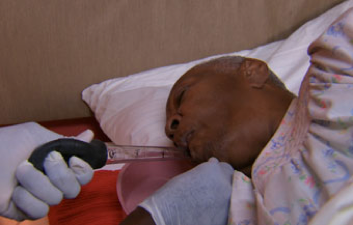A person who drools liquids and chewed food or coughs during or after swallowing is at risk for choking. Or, if the person pockets food and saliva in the side of their mouth, or takes a long time to eat, he or she should be watched for choking during mouth care.

Have the person spit out the secretions and sit up straight. If you have a gravy baster or large bulb syringe, remove secretions from the mouth. Use caution: Do not squeeze the baster and force fluid back into the mouth. See the Show Me How section of this lesson. Or, if a person is lying on their side, keep them in that position with their head turned down. This aids breathing.
(See our lesson on Feeding a Person).
Replace a toothbrush every 3 or 4 months, or after a person has been sick from a cold or sore throat. It is also good to replace a toothbrush when the bristles become worn or frayed.
Give mouth care at least twice a day, when a person wakes up and just before they go to bed. However, if the person has a dry mouth or discomfort in the mouth, offer mouth care every three hours, or as the person chooses.
No, not if you follow the steps we suggest in the Show Me How section of this lesson. If a person is at risk for choking, follow the steps we suggest that prevent spit and liquid from pooling in the back of the throat.
The American Cancer Society tells us that men are twice as likely to have oral cancer as women. Men over age 50 are at greatest risk. Cigarette, cigar and pipe smokers are 6 times more likely than non-smokers to develop oral cancer. Use of smokeless tobacco and the excess ingestion of alcohol also increase the risk for oral cancer.